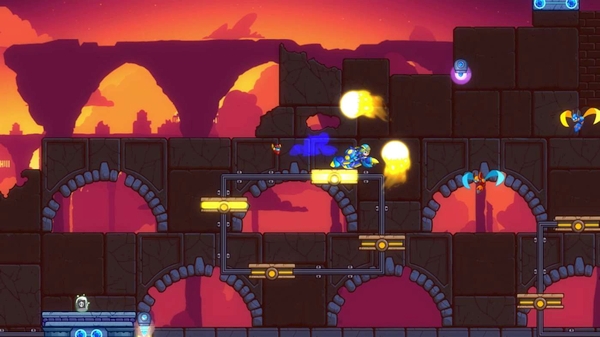
Back in 2015, we all got to relive the instantly recognizable beats of the first six games in the Mega Man series thanks to the Mega Man Legacy Collection. It was surprisingly easy to slip back into the familiar patterns of the franchise, but at the time I wondered if we’d ever get the chance to apply that muscle memory to something new. So while we continue to wait for this Fall’s Mega Man 11, the newly-released 20XX is here to fill the gap… and to prove that games inspired by the Blue Bomber can feed your nostalgia needs just as well.
Platforms: PC, PS4, Switch, Xbox One
Publisher: Fire Hose Games
Developer: Batterystaple Games
Genre: Mega Man-Style Procedurally-Generated Platformer
Release Date: August 16, 2017 (PC), July 10, 2018 (PS4, Switch), July 11, 2018 (Xbox One)
ESRB Rating: Everyone 10+
 Like Mega Man, 20XX takes place in a near-future where industrial robots have broken free of their programming and enslaved humanity. In a last-chance bid to survive, a pair of scientists escaped to The Ark, a planet-orbiting space base, and built a team of battle robots to help us fight back.
Like Mega Man, 20XX takes place in a near-future where industrial robots have broken free of their programming and enslaved humanity. In a last-chance bid to survive, a pair of scientists escaped to The Ark, a planet-orbiting space base, and built a team of battle robots to help us fight back.
While the story takes its cues from Mega Man’s Classic era, 20XX’s character designs found more inspiration in the Mega Man X sequel series. Ergo, Nina is a blue bot with an N-Cannon that she can charge up for more powerful attacks. And Ace is a red robot who swings into battle with his A-Saber laser sword.
But unlike a traditional Mega Man adventure, 20XX is a roguelike that rebuilds its game world every time you start over with procedurally-generated stages. However, while each run through the game is unique, there’s not a ton of variety in the stage designs, and it doesn’t take long for similar-looking platforming sections to appear again and again. That said, the procedural-generation engine used to stitch those sections together does its job admirably, and I had to keep reminding myself that the game was actually creating them on the fly.
To help players tackle the ever-changing stages, 20XX features an extensive series of upgrades and powerups that you can equip, known as Augments, to create the ultimate killer cyborg. Augments control every aspect of your bot, from their jumping ability to the power of their main weapon to the amount of Health they can carry. Mixing and matching Augments is a major part of 20XX. It’s great fun to remake your character in different ways each time through, as you can also steal weapons from the bosses you defeat, and call on a helper robot to bring you Nuts (which can be traded for Augments), NRG (which powers boss weapons), and Health.
But some of the customization options felt even more deliberate than you’d typically see in a procedurally-generated game.

During one of my first runs, I earned a Plumbers’s Hat (an Augment that increases the height of your jumps) and a Flameshield (a force field that rotates around you) from the first boss. Early in the next stage, I further amplified my jumping ability with a Dracopent’s Bound (Double Jump) Augment. But I also could have spent my Nuts on a few NRG-boosting Augments, which would have let me keep the Flameshield activated longer. In an entirely separate run, I picked up a pair of legs that gave me the mid-air dash in the second stage. This ability came in handy in the third stage, when I was able to dash over a series of flame-spewing platforms with ease.
Did the developer tweak the randomness of the stages and purposely make these paired upgrades appear together? I don’t know for sure, but it certainly feels like Batterystaple put a lot of effort into making sure 20XX’s stages fit together seamlessly.
Each run of 20XX includes ten stages, and the further into the game you get, the more complex the stages become. After each boss fight, you’ll receive three choices for which boss you want to fight next, so there’s a limited set of choices for the route you take through the game, but enemies and bosses load up with extra guns and more powerful armor in later stages. So that means the strategy you’ll need to employ against a boss, such as the wolf-like Kur, in Stage 1 will be completely different than the one you’ll need to defeat him if he’s standing at the end of Stage 8. It’s a neat way to honor the Mega Man series’s trademark trick of allowing players to fight the bosses in any order while still doing something slightly different.
In addition to the game’s main procedurally-generated mode (which can also be played with a partner in local or online co-op), 20XX is packed with extra modes including Daily Challenges, Weekly Challenges, and a Boss Rush mode. The game even gives you the chance to customize your run with optional Skulls that can ramp up the difficulty to insane heights. Just turning on one or two Skulls will quickly make the game harder than the original Mega Man.
20XX is an absolutely fantastic platformer, and having the ability to recreate your character with over a hundred different Augments makes each run feel even more unique. Batterystaple Games absolutely nailed the Mega Man formula, and the visual design constantly pinged the Mega Man X memories bouncing around my brain. But the developer also produced a game that is sure to stand on its own.
Mega Man fans might be tempted to pick up 20XX to pass the time until the launch of Mega Man 11, but I’m positive they’ll continue playing it far into the future.

Review Disclosure: A review copy of 20XX for the Xbox One was provided by Batterystaple Games for the purposes of this review.







